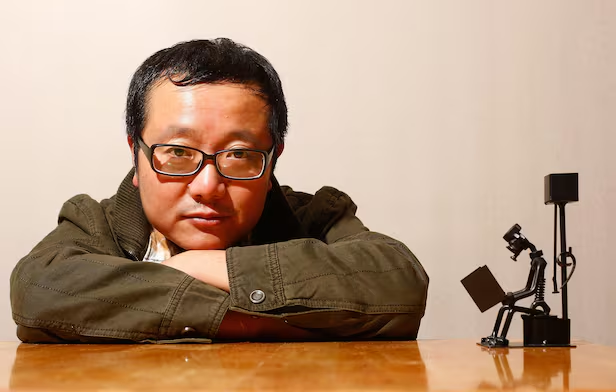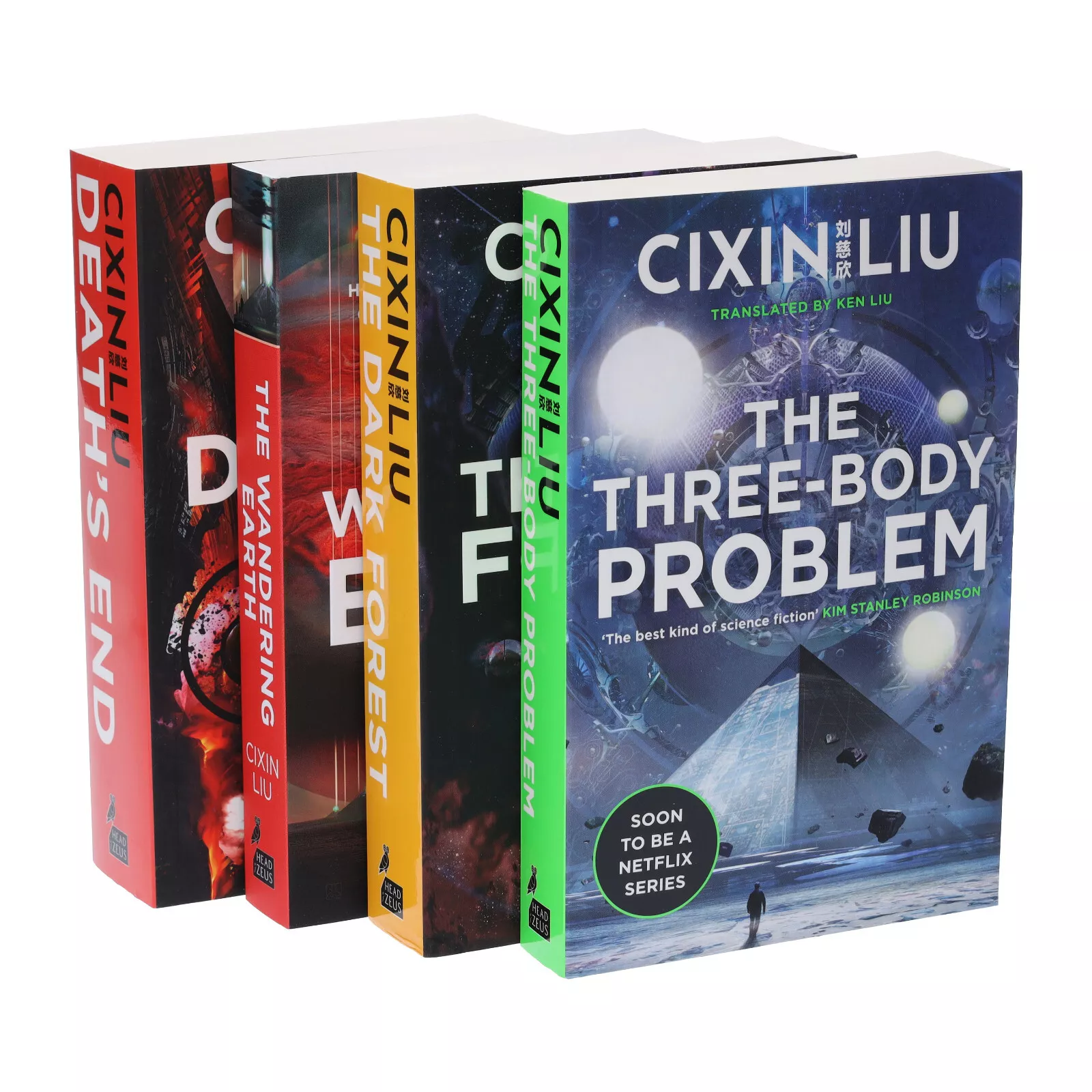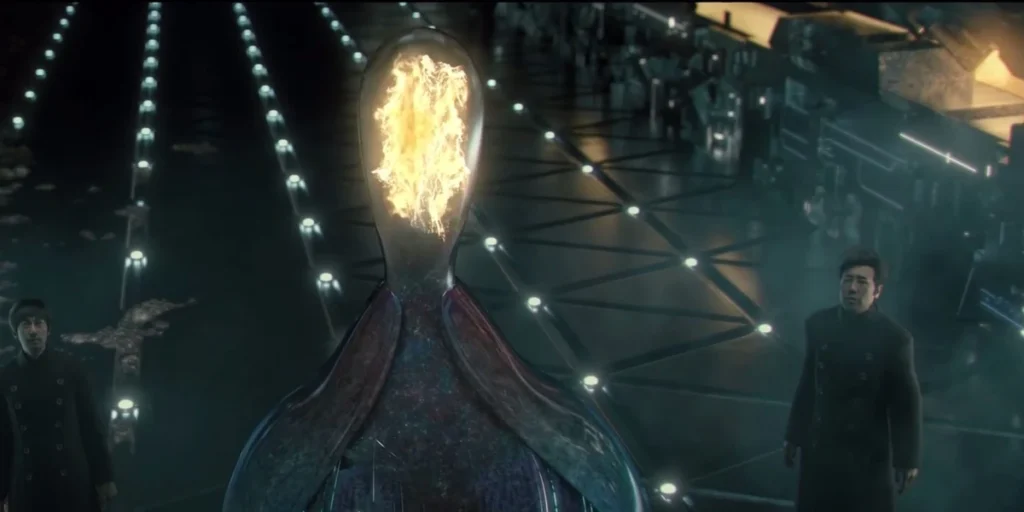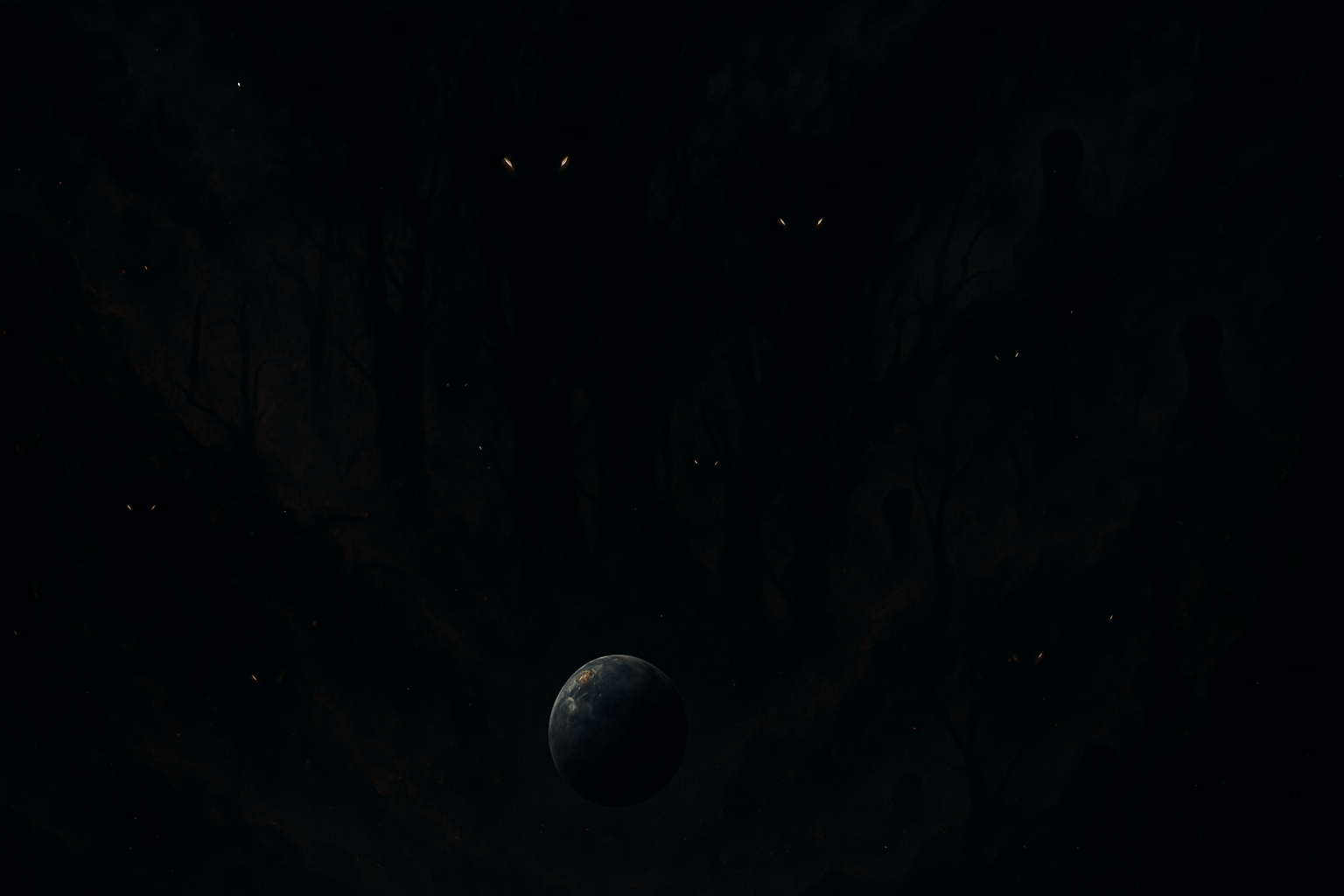Are we alone? The universe’s sheer scale is immense. Billions of galaxies, each holding billions of stars, suggest that life, even intelligent life, should be abundant. Yet, despite our searches, the cosmos remains eerily silent. Scientists call this profound disconnect the Fermi Paradox. Many theories attempt to explain this “Great Silence.” However, few are as chilling or thought-provoking as the Dark Forest Hypothesis. Chinese science fiction author Liu Cixin popularized this theory in his acclaimed “Remembrance of Earth’s Past” trilogy, often known by its first book, “The Three-Body Problem.” His theory suggests the silence is not an absence of life. Instead, it is a terrifying testament to a universal survival strategy in an inherently dangerous universe.
What is the Dark Forest Hypothesis?
The Dark Forest Hypothesis provides a stark answer to why we have not detected alien civilizations, despite their statistical likelihood. The theory’s core idea is simple yet terrifying.
The Cosmic Wilderness: A Universe of Hunters
Imagine the universe as an immense, unlit forest. In this cosmic wilderness, every technologically advanced civilization acts like an armed hunter. They tread silently and cautiously. Survival is the paramount rule. Given certain unforgiving axioms, the most rational behavior is to remain hidden. If a civilization carelessly reveals its presence—for instance, by broadcasting signals into space—it is like a hunter lighting a fire. This act instantly makes it a target for every other hidden hunter nearby.
Foundational Axioms of Cosmic Sociology

Liu Cixin / credits: Baidu Baike
Liu Cixin’s work outlines key premises, often linked to “cosmic sociology,” that build the underlying logic. These axioms paint a picture of interstellar relations governed by harsh realities:
- Survival as the Primary Drive: Every civilization’s most fundamental instinct is survival. This need overrides all other considerations.
- Continuous Growth and Expansion: Life, by its nature, seeks to propagate. Civilizations strive to utilize more resources as they grow.
- Finite Universal Resources: While the universe is vast, its resources are not infinite. This finiteness could eventually lead to competition on cosmic timescales, a core concept in cosmic sociology.
- The Unbreakable Chain of Suspicion: One civilization cannot be certain of another’s true intentions. Vast interstellar distances and potentially eons of different evolutionary paths make trust impossible. Benevolence is not guaranteed. Even a currently peaceful civilization might become hostile with technological advancement or changing circumstances. This mutual, unresolvable suspicion prevents trust.
- The Threat of Technological Explosion: Technological progress can be unpredictable and exponential. A civilization that seems primitive today could rapidly develop technologies making it an existential threat in a short cosmic timeframe. Therefore, waiting to assess a newly discovered civilization’s intentions is a gamble. Most hunters in the Dark Forest are unwilling to take this risk.
Silence or Elimination
Given these conditions, the hypothesis argues for a grim choice. The safest course for any civilization is to remain utterly silent and undetectable. Alternatively, upon detecting another civilization, it must preemptively eliminate it before it can pose a threat. The “extraterrestrial silence” we observe, therefore, does not signify an empty universe. Instead, it suggests a universe filled with civilizations too terrified to speak. This explanation of the “Dark Forest theory” paints a bleak picture of interstellar relations, directly addressing the question: “Why aliens stay quiet?”
Who Created the Dark Forest Hypothesis and What Inspired It?
Chinese science fiction author Liu Cixin is the architect most famously associated with the Dark Forest Hypothesis. He masterfully wove it into the fabric of his narrative.
Liu Cixin: Architect of the Dark Forest
Liu Cixin presented the most detailed and widely known formulation of the Dark Forest Hypothesis. It is a central theme in his 2008 novel, “The Dark Forest” (黑暗森林). This book is the second volume in his epic “Remembrance of Earth’s Past” trilogy. The series gained international fame with its first book, “The Three-Body Problem.” While the general idea of a dangerous cosmos or predatory aliens appeared in earlier science fiction, Liu Cixin crystallized these notions. He created a coherent and compelling game-theory-based framework, giving it the evocative name that has captured public imagination.
 Buy Liu Cixin’s Masterpiece on eBay
Buy Liu Cixin’s Masterpiece on eBay
Inspirations: Game Theory, History, and Cosmic Pessimism
Liu Cixin’s inspirations for the theory are likely multifaceted. The narrative itself suggests a foundation in a ruthless application of game theory and rational choice theory to a cosmic scale. Here, survival is the ultimate payoff. The “chain of suspicion” and the logic of preemptive strikes echo concepts from Cold War-era strategic thinking, such as Mutually Assured Destruction (MAD). However, Liu applies these to a far grander and more terrifying stage. The hypothesis also serves as a powerful critique of overly optimistic first contact fears and scenarios often portrayed in science fiction. It forces a confrontation with a more pessimistic, yet arguably logical, possibility.
Furthermore, the theory delves into existential risk, exploring the ultimate dangers a species could face. Liu Cixin himself has indicated the Dark Forest is a hypothesis within his fictional universe. It is a logical deduction based on the axioms he lays out for his cosmic sociology. It is not necessarily his personal belief about our universe’s actual state. Nevertheless, its intellectual rigor and dramatic power have significantly contributed to discussions surrounding the Fermi Paradox and humanity’s place in the cosmos.
The Dark Forest as Explained in “The Three-Body Problem” Series
In Liu Cixin’s narrative, particularly in “The Dark Forest,” the hypothesis is not merely an abstract concept. It is a driving force of the plot and a fundamental law governing the universe. The “Three-Body Problem explained” through this lens reveals a deeply perilous cosmos.
Narrative Context: Earth, Trisolaris, and the Sophon Threat
Humanity faces an impending invasion by the technologically superior Trisolarans. Their fleet is set to arrive in roughly 400 years. Trisolaran supercomputers, known as sophons, cripple Earth’s defenses. Sophons can monitor all human activity and communication. They also disrupt fundamental scientific research on Earth. However, a crucial limitation exists: sophons cannot read human minds.

Trisolarans | Three Body Problem Wiki | Fandom
The Wallfacer Project and Luo Ji’s Revelation
This limitation leads the United Nations to create the Wallfacer Project. Four individuals become “Wallfacers.” They must devise secret strategic plans to defend Earth. Their true intentions remain hidden even from their own species until the moment of execution. Luo Ji, an unassuming sociologist, is one of these Wallfacers. He eventually uncovers and formalizes the Dark Forest theory. He realizes the universe operates on these grim principles after reflecting on cryptic advice from Ye Wenjie. Ye Wenjie was the astrophysicist who made the initial contact with Trisolaris.
Luo Ji’s understanding of cosmic sociology leads him to identify the core axioms. These include the primacy of survival and the continuous expansion of civilizations in a resource-limited universe. More critically, he grasps the implications of the “chain of suspicion.” This is the inability of civilizations to trust each other’s long-term intentions. He also understands the “technological explosion,” where a weaker civilization could rapidly become a threat. To test his theory, Luo Ji arranges for the broadcast of a distant star’s location into the cosmos. Decades later, after hibernation, confirmation arrives: an unknown party destroyed the star. This validates the terrifying reality of the Dark Forest.
Cosmic Sociology and the Ultimate Deterrent
This knowledge becomes Earth’s ultimate, albeit desperate, deterrent. Luo Ji leverages the Dark Forest state. He threatens to broadcast the Trisolaran home world’s location to the wider universe. This act would also expose Earth’s solar system due to their relative proximity. Such a broadcast would invite destruction upon both civilizations from other, more powerful, hidden “hunters.” This threat of mutual annihilation forces the Trisolarans into a temporary, uneasy truce. It fundamentally alters the course of the human-Trisolaran conflict.
 Explore the Three-Body Universe Now
Explore the Three-Body Universe Now
Why Haven’t We Found Aliens Yet? Could the Dark Forest Be the Reason?
The Fermi Paradox puzzles scientists. It highlights the contradiction between the high probability of alien existence and the lack of contact. “Why aliens stay quiet” is a question with many answers. These range from the mundane (we haven’t looked hard enough) to the profound (life is incredibly rare). The Dark Forest Hypothesis offers one of the most unsettling explanations.
The Silence as a Survival Strategy
The Dark Forest theory suggests aliens are out there. However, they remain silent and hidden out of self-preservation. If this theory holds true, then our very act of searching for extraterrestrial intelligence (SETI) could be dangerous. Broadcasting our existence, as with the Arecibo message or Voyager Golden Records, might be an act of existential folly.
If the universe is indeed a dark forest, then several conclusions follow. The silence is a rational outcome; survivors learn to be quiet, while others are eliminated. Our current search methods might be naive if everyone avoids detection. Humanity’s relatively noisy presence could be perilous if hunters have already noted our signals.
This perspective transforms the question “Are we alone in the universe?” It becomes a more chilling one: “Are we alone, or are we simply naive newcomers who haven’t yet learned to fear the dark?”
What Does the Dark Forest Symbolize?
Beyond its literal interpretation as a solution to the Fermi Paradox, the Dark Forest Hypothesis has become a potent cultural symbol. It encapsulates several deep-seated human anxieties and philosophical considerations.
It taps into cosmic horror and existential dread. The universe becomes a place of lurking, unseen threats, not just wonder. It serves as a cautionary tale about unfettered curiosity. Our drive to explore could be our undoing. The theory also highlights the fragility of trust. If trust is hard on Earth, how much harder is it between alien species?
Furthermore, the Dark Forest resonates with modern risks. It is a metaphor for anxieties about AI and existential risk. The fear of a misaligned superintelligent AI mirrors Dark Forest dynamics. In an age of mass surveillance, the idea that visibility equals vulnerability has powerful parallels.
How Likely is the Dark Forest Hypothesis to Be True? Could It Be Real?
Determining the Dark Forest Hypothesis’s true probability is currently impossible. We have only one data point for life (Earth). We lack confirmed evidence of extraterrestrial intelligence. However, we can assess its plausibility based on its underlying assumptions.
Assessing Plausibility: Arguments For
Several factors lend some plausibility to the theory. Self-preservation is a powerful, arguably universal, driver for life. Extreme caution could be an evolutionarily stable strategy. In situations of imperfect information and high stakes (like first contact fears), suspicion and preemptive action can appear rational from a self-interested game theory perspective. The vastness of space and time could also exacerbate the “chain of suspicion.”
Assessing Plausibility: Arguments Against
However, strong arguments also challenge its likelihood. The theory may project human paranoia onto all alien civilizations (anthropomorphism). It assumes a universal adherence to grim logic, ignoring potential diversity in alien motivations like curiosity or cooperation. The universe’s resources may not be as scarce for advanced civilizations as the theory implies. Interstellar warfare would be incredibly costly, while cooperation could offer immense benefits.
So, Could It Be Real?
Could the Dark Forest Hypothesis be real? Yes, it is a logically coherent possibility under specific pessimistic assumptions. We cannot definitively disprove it with current knowledge. However, many scientists and thinkers consider it an extreme and less probable solution to the Fermi Paradox. It serves as a compelling thought experiment about a potential worst-case cosmic scenario.
What is the Difference Between the Dark Forest Hypothesis and the Zoo Hypothesis or the Great Filter?
To better understand the Dark Forest Hypothesis, comparing it with other prominent theories for the Fermi Paradox is helpful. These include the Zoo Hypothesis and the Great Filter.
Dark Forest Hypothesis vs. The Zoo Hypothesis
The Zoo Hypothesis suggests advanced aliens exist and know of us. However, they deliberately avoid interference, observing us as if in a cosmic zoo. Their motives could be ethical, scientific, or policy-based. The key difference lies in motivation. The Dark Forest posits fear and self-preservation drive silence. The Zoo Hypothesis suggests ethical considerations or scientific detachment from observers cause non-contact.
Dark Forest Hypothesis vs. The Great Filter
The Great Filter proposes a critical developmental barrier for life. This barrier is exceptionally hard to overcome on the path to a space-faring civilization. It could be in our past (making us rare) or our future (a dire prospect). The key difference is focus. The Great Filter concerns intrinsic barriers to a civilization’s development. The Dark Forest concerns extrinsic threats from interactions between existing civilizations. The Dark Forest itself could be a form of Great Filter, culling visible civilizations.
Modern Interpretations on Reddit and in Sci-Fi Fandom
The Dark Forest Hypothesis has resonated deeply within science fiction fandom and online communities like Reddit. Subreddits such as r/threebodyproblem, r/scifi, and r/futurology frequently host discussions dissecting the theory.
Online Debates and Cultural Impact
These debates often explore its logical consistency and perceived flaws. Participants discuss its psychological impact on readers and its place in sci-fi canon. They compare it with other Fermi Paradox solutions. The theory’s metaphorical relevance to current global issues, including AI safety and advanced technology risks, is also a hot topic. Many fans find it compelling and terrifyingly plausible. Others critique it as overly pessimistic or based on a human-centric view of alien psychology. The phrase “Dark Forest theory” has become shorthand for this specific, grim vision of the cosmos.
Popular Criticisms and Counterarguments (e.g., “The Dark Forest Hypothesis is absurd”)
Despite its narrative power, the Dark Forest Hypothesis faces numerous criticisms. Many argue that the “Dark Forest Hypothesis is absurd” when considered as a literal depiction of galactic reality.
Questioning Universal Behavior and Practicality
Critics argue it’s unlikely that all alien civilizations would adopt such a paranoid strategy. Diversity in alien psychology and ethics would likely lead to varied behaviors. The premise of inevitable resource conflict is debatable; advanced civilizations might overcome scarcity. The potential gains from cooperation could outweigh perceived contact risks. Furthermore, effectively monitoring the entire galaxy and eliminating any emerging civilization presents monumental practical challenges.
The “Loudest Kid on the Block” Problem
If the Dark Forest is real, why hasn’t Earth, a noisy civilization for a century, been silenced? This could imply the theory is wrong. Perhaps we are too insignificant. Or maybe the “hunters” are not as omniscient or quick as the theory suggests. Other, less hostile dynamics might also be at play. These criticisms highlight the complexities of predicting hypothetical alien behavior.
If the Universe is a Dark Forest… Should We Be Hiding, or Should We Be Sending Signals?
The Dark Forest Hypothesis, with its chilling vision, forces humanity to confront a profound question: what should be our cosmic strategy? If there’s even a small chance the universe operates on these grim principles, the implications for SETI and our actions are monumental.
One perspective, dictated by Dark Forest logic, is that silence and stealth are paramount. Announcing our presence could be reckless, like shouting in a jungle of predators. Humanity should perhaps minimize its cosmic signature and develop observation-only technologies. The fear of first contact turning catastrophic looms large.
Conversely, succumbing to Dark Forest paranoia might mean forfeiting immense opportunities. What if the universe is not uniformly hostile? What if benevolent or neutral civilizations exist? Self-imposed isolation could lead to stagnation. Perhaps a degree of cautious openness, or continued listening before shouting, is more balanced. Some argue that reaching out tests a civilization’s maturity, a move beyond pure self-preservation.
Others suggest focusing on our own world, addressing internal existential risks (like climate change or uncontrolled AI), and understanding the universe better before knocking on its potentially dangerous doors. This discussion touches upon speculative science and even concepts like de-extinction, as we ponder life’s long-term fate.
The question of hiding or signaling has no easy answer. It lies at the intersection of scientific uncertainty, philosophical debate, and our deepest hopes and fears. The Dark Forest Hypothesis, whether a true reflection of galactic reality or masterful fiction, serves as an invaluable catalyst for this critical reflection. It compels us to think deeply about humanity’s future, the nature of intelligence, and the profound responsibility of being a sentient species on the cusp of potentially reaching for the stars.



One thought on “The Dark Forest Hypothesis: Cosmic Silence or a Universe of Hidden Hunters?”